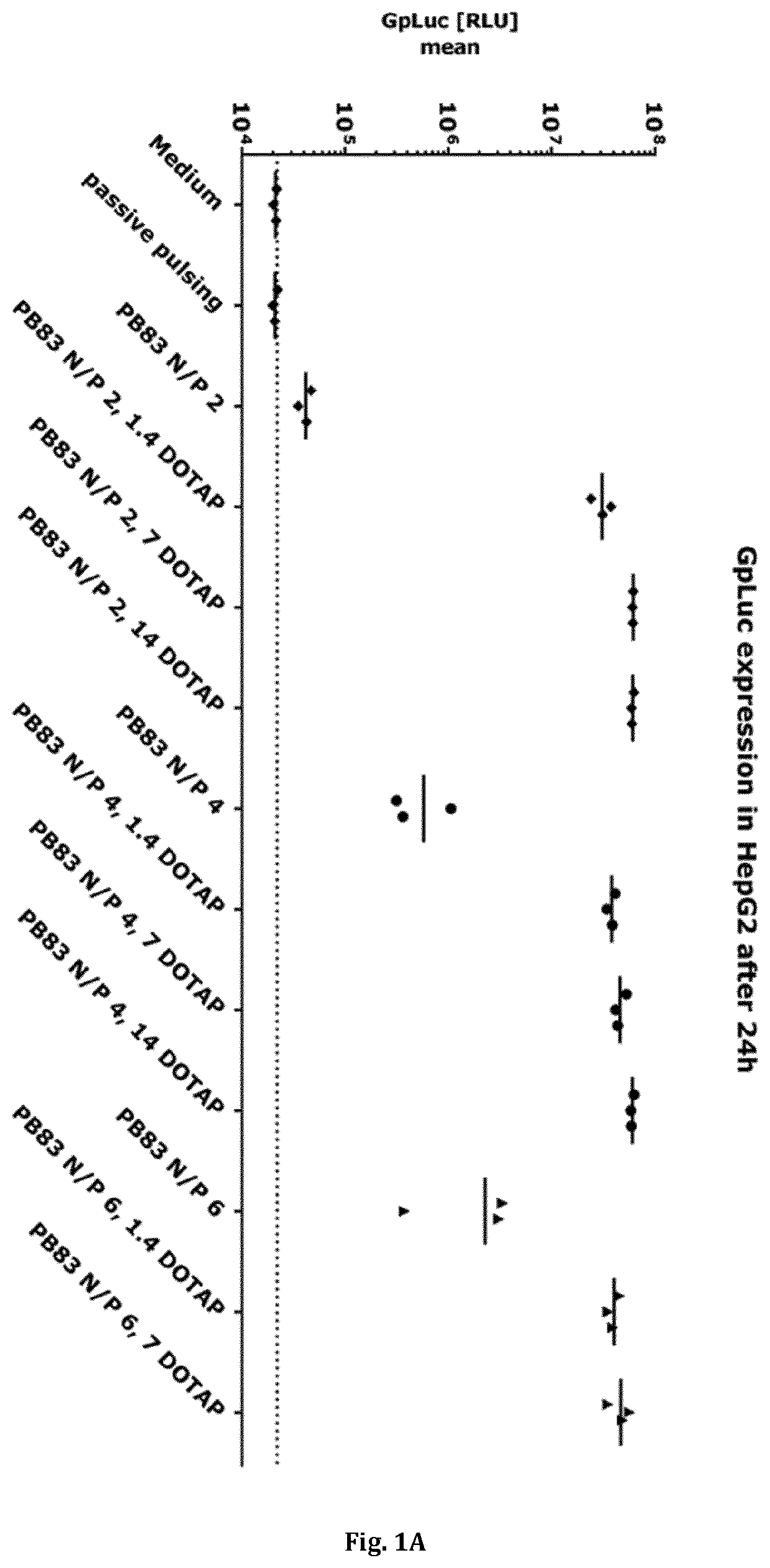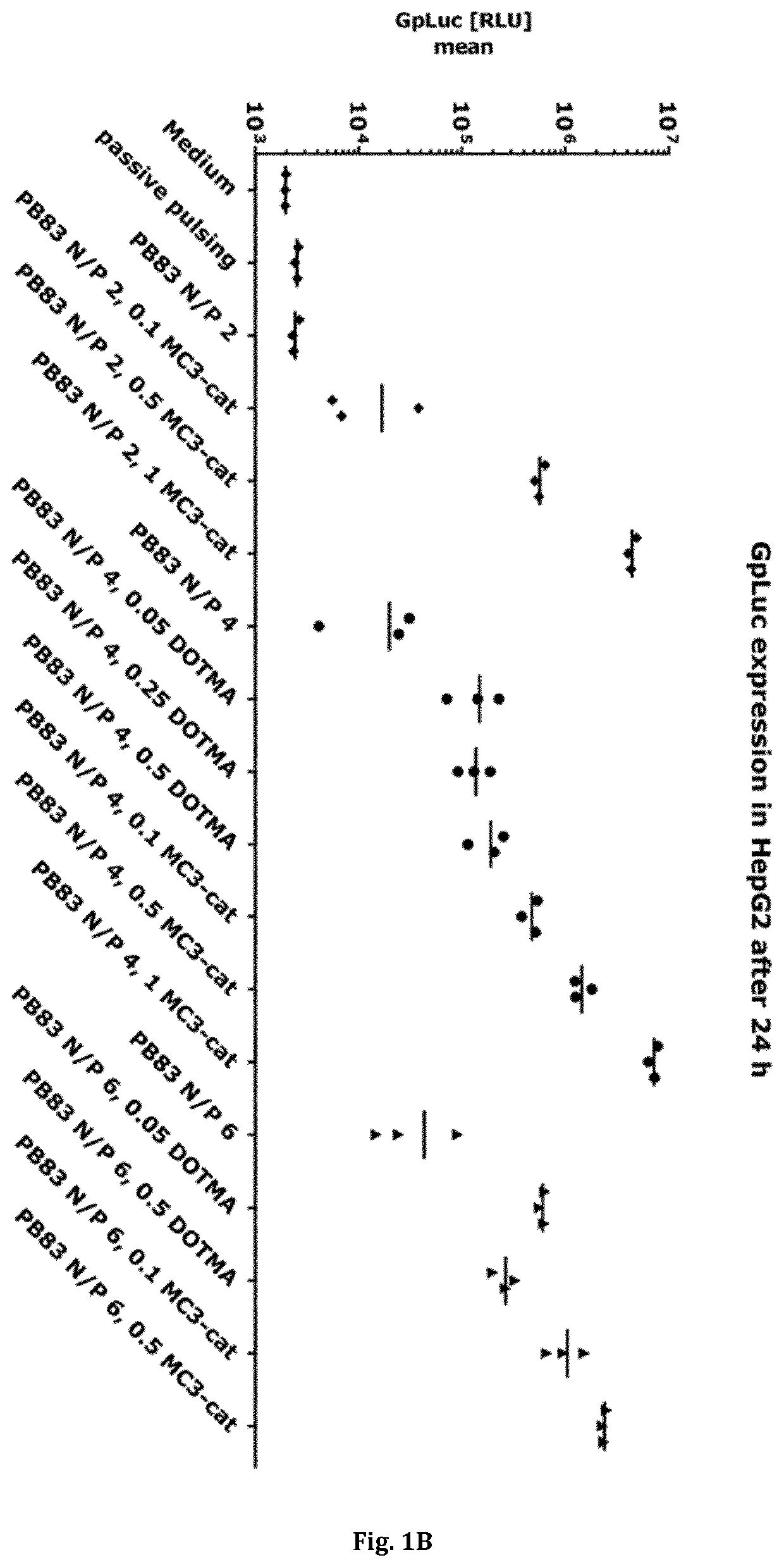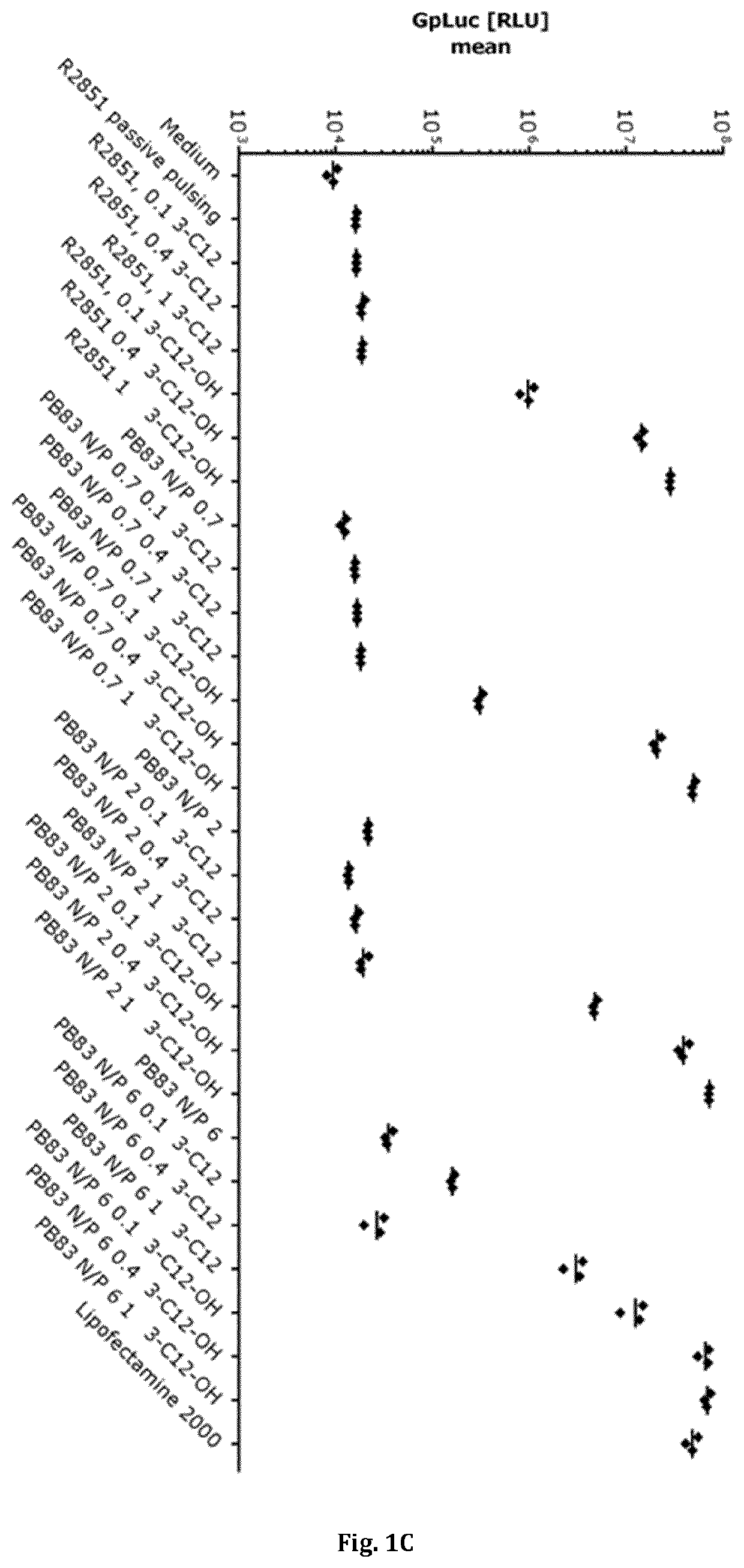Cationic carriers for nucleic acid delivery
a nucleic acid and carrier technology, applied in the field of medical therapy, disease prevention and drug delivery, can solve the problems of poor cellular access, ineffective delivery, and difficulty in delivering to biological targets, and achieve the effect of effective delivery
- Summary
- Abstract
- Description
- Claims
- Application Information
AI Technical Summary
Benefits of technology
Problems solved by technology
Method used
Image
Examples
example 1
on of DNA and mRNA Constructs
[0651]For the present examples, a DNA sequence encoding Gaussia princeps luciferase (GpLuc), Photinus pyralis luciferase (PpLuc) and Mus musculus erythropoietin (MmEpo) was prepared and used for subsequent RNA in vitro transcription reactions. The obtained mRNA constructs were used for further in vitro and in vivo experiments. The respective amino acid sequences, the mRNA sequences of GpLuc, PpLuc and MmEpo as well as preparation step details are provided below.
GpLuc, amino acid sequence (SEQ ID NO: 11):MGVKVLFALICIAVAEAKPTENNEDFNIVAVASNFATTDLDADRGKLPGKKLPLEVLKEMEANARKAGCTRGCLICLSHIKCTPKMKKFIPGRCHTYEGDKESAQGGIGEAIVDIPEIPGFKDLEPMEQFIAQVDLCVDCTTGCLKGLANVQCSDLLKKWLPQRCATFASKIQGQVDKIKGAGGDPpLuc, amino acid sequence (SEQ ID NO: 12):MEDAKNIKKGPAPFYPLEDGTAGEQLHKAMKRYALVPGTIAFTDAHIEVDITYAEYFEMSVRLAEAMKRYGLNTNHRIVVCSENSLQFFMPVLGALFIGVAVAPANDIYNERELLNSMGISQPTVVFVSKKGLQKILNVQKKLPIIQKIIIMDSKTDYQGFQSMYTFVTSHLPPGFNEYDFVPESFDRDKTIALIMNSSGSTGLPKGVALPHRTACVRFSHARDPIFGNQI...
example 2
Different Polymer-Lipid(oid) Formulations on Transfection Efficiency of HepG2 Cells In Vitro
[0679]This example describes the evaluation of the effect of different polymer-lipid(oid) formulations (as described under Example ▪1) on transfection efficiency on HepG2 cells (human liver carcinoma cell line). As a read-out for transfection efficiency, GpLuc mRNA (SEQ ID NO: 14) was used as a cargo. Successful transfection with the cargo leads to the translation of the luciferase protein and to a secretion of Gp luciferase protein into the cell culture supernatant.
Transfection of HepG2 Cells:
[0680]A volume of 0.2 mL HepG2 cells (10.000 cells) were seeded in a 96 well tissue culture plate. After removing the medium from each well, 100 μL RPMI 1640 medium (with 1% Penicillin and 1% Streptomycin, 1% L-Glutamin) was added to each well. Afterwards, HepG2 cells were transfected with 100 μL transfection mix (in triplicates) of the above described polymer-lipid(oid) mRNA complexes and respective co...
example 3
Different Polymer-Lipid(Oid) Formulations on Transfection Efficiency of Differentiated Sol8 Muscle Cells In Vitro
[0686]The purpose of this example is to assess the effect of lipid additives such as permanently cationic lipids or lipidoids on transfection / expression efficiency in Sol8 cells. It shows that the positive effect of the inventive polymer-lipid(oid) formulations (as described under Example 1) on transfection efficiency observed in Example 2 also translates to other cell types such as Sol8 muscle cells. Sol8 is a myogenic cell line isolated by Daubas et al. from primary cultures of soleus muscle taken from the leg of a normal C3H mouse. As a read-out for transfection efficiency, GpLuc mRNA (SEQ ID NO: 14) was used as the cargo. A successful transfection with the cargo leads to the translation of the luciferase protein and to a secretion of Gp luciferase protein into the cell culture supernatant. For further details on the GpLuc mRNA cargo see Example 1.
Transfection of Sol8 ...
PUM
| Property | Measurement | Unit |
|---|---|---|
| Substance count | aaaaa | aaaaa |
| Zeta potential | aaaaa | aaaaa |
| Zeta potential | aaaaa | aaaaa |
Abstract
Description
Claims
Application Information
 Login to View More
Login to View More - R&D
- Intellectual Property
- Life Sciences
- Materials
- Tech Scout
- Unparalleled Data Quality
- Higher Quality Content
- 60% Fewer Hallucinations
Browse by: Latest US Patents, China's latest patents, Technical Efficacy Thesaurus, Application Domain, Technology Topic, Popular Technical Reports.
© 2025 PatSnap. All rights reserved.Legal|Privacy policy|Modern Slavery Act Transparency Statement|Sitemap|About US| Contact US: help@patsnap.com



